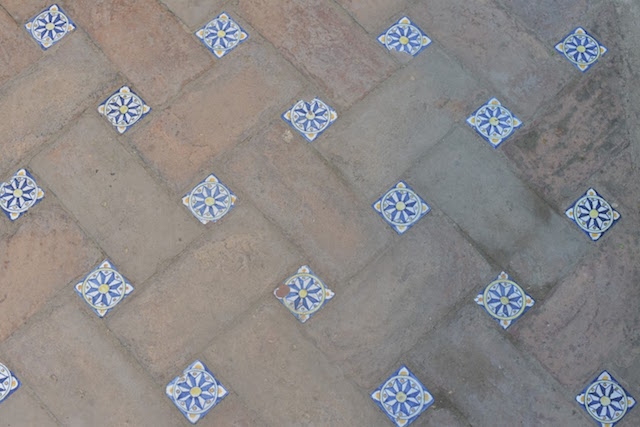
Azulejos on one of the floors in Sevillas Alcázar.
Text and photos by Pete Shaw
October 12, 2018
Dear Margaret,
I speak Spanish. This is a truth. An even greater truth would be to say that I speak it poorly. Languages are not my thing. I never got down programming a computer. I can’t read music. And I took seven years of Spanish to finish on a third year level. Somehow on my third go-round at Spanish 1, I took home a B-. Because I make lemonade, I’ll say that I have an extremely firm and experienced grasp of the rudiments of the language.
Despite my ineptitude with languages, I enjoy them. Greatly. They fascinate me.
They also come in handy. I consider it of high importance to, at the very least, know how to ask someone where I can find a train, decent bakery, and toilet.
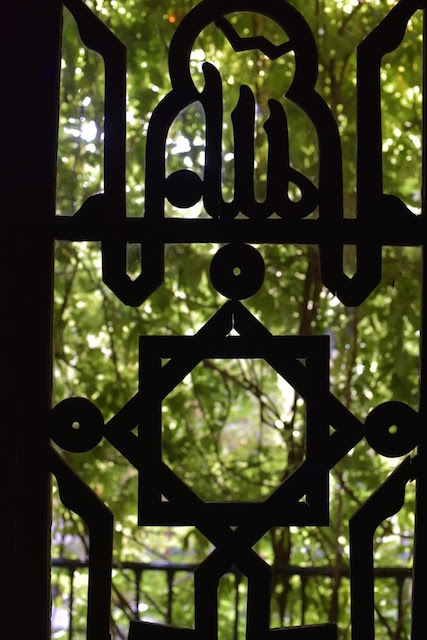
Window screen in Sevilla’s Alcázar.
And oddly enough, people tend to treat you a bit more kindly when you show you have made an attempt to learn their language. One of my Friend’s in-laws had an issue with this idea. He had been to Paris a few years back, and he found the Parisians to be as terrible as in lore. One of his complaints was that they did not speak English, which clearly they should have been doing. He seemed shocked when I told him I found it quite productive to head off such problems by trying to learn their language. After all, you are entering their home, and in most cases it is poor form to shit on someone’s rug.
I stopped there. He does not seem the sort who can conjugate the verb enjoy, and so there seemed no point in noting how much more fun you can have by taking the time to at least learn the present tense and some key vocabulary, along with the requisite hello, goodbye, thank you, and you’re welcome.
For me, this is where any travel gets its highlights. Yesterday, Jessica and I were wandering the streets of old Sevilla, and about a couple of blocks from where we are staying, we hopped into a shop that sells azulejos, the tiles that are found in many of the old buildings here. The guy who owns the store takes the azulejos from razed sites, scrapes the mortar from them, and then sells them to people who want to refurbish their homes. Some of the ones he sells approach 200 years old. They are pretty, and they were clearly built to last. I noted to him that many of the ones we saw for sale in the Triana neighborhood, just across the Guadalquivir River from old Sevilla, were much thinner.
He lives in Sevilla, but about 25 minutes from his shop. He likes animals, and he has dogs, cats, chickens, and even a peacock. I told him that I thought Granada’s Alhambra was a neater place than Sevilla’s Alacázar. Like the Alhambra, it too is a combination palace and fort. It is similar in its mesmerizing structures, decorations, and gardens, but it is much smaller and a little shabbier. The presence of peacocks–I saw none in Granada–made it worth every penny (to be fair, the Alcázar, while not up to the Alhambra, is still awesome).
Peacocks, he told me, are clever. When it took up roost at his home, he at first tried to get it to leave. It would not. He even threw a few potatoes at it. The peacock dodged them. He figured any animal willing to stand its ground in such a fashion was worth keeping on. An unfortunate result is that one of his roosters, who had been the boss, was relegated to second division. This, he thinks, eventually resulted in its death.
He likes New York City. He asked if I was from there. I guess my New Jersey accent, which has a lot of my folks’ Brooklyn upbringing lodged in it, gave me away. He was once in The City. He enjoyed it, but he would not want to live there. He feels he is too old for it now. Who would he know? Who can you know in a city so big?
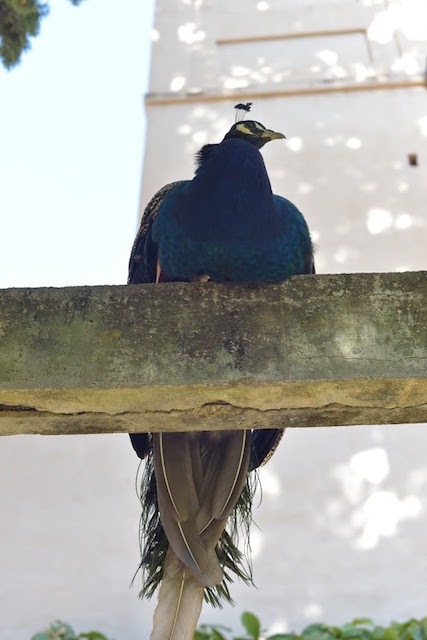 Forty-five minutes later, we left his store with 8 small azulejos. It was the best 30 Euros I ever spent. We leave here in a few hours. I hope we have enough time to drop in and say goodbye.
Forty-five minutes later, we left his store with 8 small azulejos. It was the best 30 Euros I ever spent. We leave here in a few hours. I hope we have enough time to drop in and say goodbye.
I came to Spain assuming most people spoke English. I am not sure why I believed this. But I did, and they do not. Well, they speak some English, but for the most part, it is on a level a bit more advanced than my Spanish. This does not bother me. In fact, I welcome it as a wonderful opportunity. It is a friendly puzzle, using limited vocabulary to learn new words, gained by asking, “Cómo se dice…” followed by some description of the unknown word. It is a delicate dance that if followed through, results in an oddly profound relationship built upon this extremely intimate interaction of sharing life and story across a tall but surmountable wall, knowing that despite this intense energy, you will likely never see this person again.
For the life of me, I will never understand the people in the US who think all you need to know–all you should know–is English. Never mind that this is clearly false both in terms of practicality and horizon expansion. I probably would have shit my pants twice already on this trip if I did not know how to ask for directions to the nearest bathroom, and on one of those occasions where you needed to buy something in the cafe if you were going to make use of its facilities, I would have missed out on a nice human moment.
My timing was perfect as the men’s bathroom had just been cleaned. In I went, and out I came. When I returned to my drink, Jessica went to do her business. She came back and asked me if I had tipped the woman who had cleaned the bathroom, as is customary. I had not, and so I went back, and I apologized for the oversight. When I gave her the coin, she thanked me and told me the bathroom was ready to go. When I explained to her that I had already used it (the past participle was about as far as I got with Spanish grammatical structures) but had forgotten to leave her the tip, she profusely thanked me for being so considerate.
How much in life are you missing out on–never mind these wonderful daily interactions of extreme mundanity–because you refuse to educate yourself well enough that you can better understand another person and the culture from which she was formed?
What is even the point of that kind of life?
Cómo se dice ‘I enjoy punching myself in the groin’?
Love,
Peter
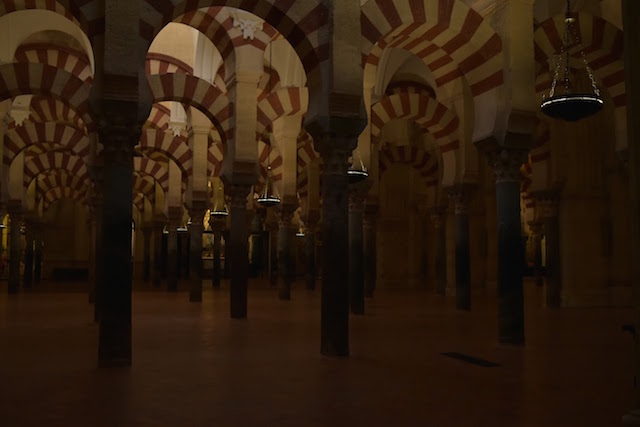
The Mezquita, early morning.
October 14, 2018
Dear Joannie,
Townes Van Zandt once sang that there was no prettier sight than looking back on a town you left behind. I am guessing he had never been to Córdoba. It stays with you.
Córdoba does not attract the number of visitors that frequent Granada and Sevilla, and far more often than not, when I told Friends where we were going on this trip, it was the one place people had never heard of. In some ways I suppose there is not much to it from a tourist standpoint. Well, strike that, because it does have the Mezquita, the old Mosque-Cathedral that sits atop a site that has been some kind of temple for over 2,000 years. But beyond that, it has an Alcázar and an old Roman Bridge and a slew of narrow, labyrinthine streets that remind you the only reason you want to know where you are is so you can get lost again. It is in many ways another run of the mill place, but like any place, throw in some time and effort, and you realize you are walking among diamonds.
In Andalusia, many people speak with some degree of a lisp, which if memory serves is because at one point the king of the region had one. It seemed good form to follow his lead, and it remains. In Córdoba, it was more pronounced–always, it seemed on a “c” followed by a vowel–than I heard in Granada and Sevilla.
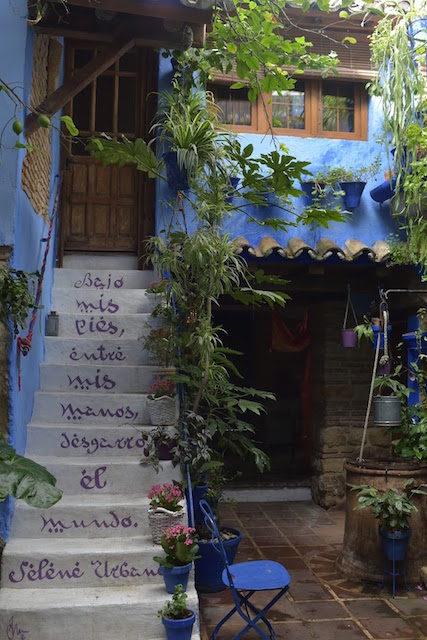
Virginia’s patio.
It is combined with shortened words and has resulted in a dialect unique to Córdobans. For example, they say “gracia” (pronounced “grathia”) for thank you, and they shorten the reply, “de nada,” to nada. Their “s” sound at the end of a word, on the rare occasion when it is not cut off, is curt. One Córdoban took the time to tell me that folks in Madrid drag on their ending “s” for far too long. Children grow up speaking this form of Spanish, but when they go to school, they must learn the official version. At first, when talking with a Córdoban, they will speak formal Spanish. But I found they quickly will take on their dialect if you do. It seemed good manners to give it a whirl, and as usual, showing such a display of common decency brought great rewards.
Those gains were amplified by us staying about as far from the tourist area as one could while still being in the old town. A real neighborhood. We stayed with a woman named Virginia, and her husband and two children. You would have fallen in love with the place. It is a small two story home, with a patio in the middle, a feature common to many homes here. Córdobans have a thing for their patios, which in English translates to courtyards. In fact, in the tourist zone, you can pay five Euros to see five award winning patios. It is a racket, but one worth supporting. Along the walls of their patios, people have flat backed flower pots, often a radiant blue, bolted into the stone walls. They are usually filled with geraniums, which are at the least the unofficial plant of the city. There are other flora, tastefully arranged, and I would imagine that in May, when the geraniums are in bloom, their brilliant fire engine red combined with the flower pots along the whitewashed walls is an amazing sight, if highly repetitive.
We found Virginia’s patio far more beautiful. First of all, the primary color of the walls is that vibrant blue. While the darker color sacrifices the illusion of greater space, it oozes relaxation. And while there are some geraniums, Virginia also has numerous other plants, spaced in a manner that even with a nearby drum kit (her young son is quite the musician, also playing piano and marimba, and maybe guitar. Before leaving, I told him, in my best Córdoban dialect, that I was sorry I did not get to play music with him.), hardly felt cluttered. It is a place to rest mind and body, including a thoughtful short poem written by Virginia’s daughter, painted on the stairway leading to where we stayed.
Clearly, Virginia and her husband fastidiously tend to their plants. They irrigate them with water drawn from a well dug by the Arabs, as the Moors seem to be referred to here, which is to say the hole was bored no less than seven centuries ago. It is comparatively a Spring chicken. On one side of the patio is a pillar that bears some, but far from all, the weight of the level above. It is a product of the Romans, who conquered Córdoba in 206 BC.
Virginia does not speak much English. I speak some Spanish, but poorly. The combination is a nice one. When the prize is getting to know someone, the challenge of communication is fun, and the payoff, priceless.
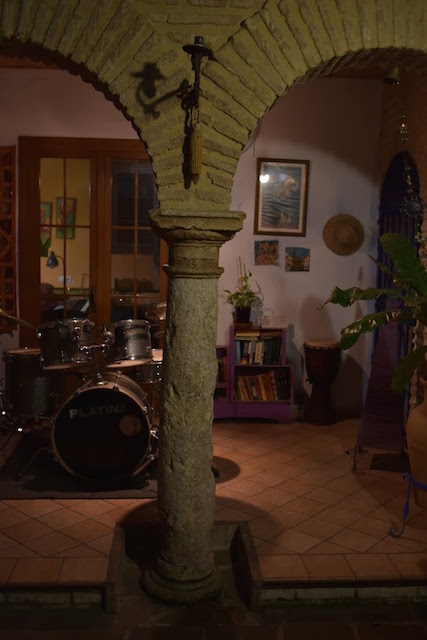
The ancient Roman column in Virginia’s home.
Outside of the people, the great prize in Córdoba is clearly the Mezquita. In its way, it is every bit as magnificent as the Alhambra in Granada. Outside of the baroque cathedral that was plopped down in the middle of it, it is a similar exercise in repetition, but with far few variances than the Alhambra.
The site has seen a lot. It began as a Roman temple, but the Visigoths razed it, making use of the pillars for their own temple. This soon gave way to the beginning of the Arab structure, which too made use of the Roman pillars. For the most part, beyond the cathedral, the structure was maintained when the Christians took over, and it has remained.
At one point, after a few expansions, the Great Mosque allowed about 50,000 devout Muslims to worship in it. That must have been a sight. I suppose you can find 50,000 people doing some kind of praying easily enough, particularly during the NFL season. But the setting is something unto itself, a series of double-tiered arches atop those nearly 900 columns whose bricks alternate between red and white, the latter having faded from jade green. On and on they seem to go. I could see how once your mind got attuned to the repetition, how settling into a trance-like state would come easily.
When the cathedral was put in during the 16th century, Charles V, king of Castile and Aragon, stated, “You have destroyed something unique to build something commonplace.” It is a fair enough statement, but to my eyes it is also wrong. Yes, the cathedral is garish, and its nave’s resplendent white ceiling which mimics the layout Michelangelo used when preparing to paint the Sistine Chapel, as well as the light coming through the dome over the altar, clashes with the more austere light in mosque. But somehow, it works.
In the Hebrew Sacred Scriptures, there is the story of the Tower of Babel, a myth that explains the variety of languages humans speak. One day folks wanted to build a tower so tall that it would reach God…an ambitious move in a time long before steel. For one reason or another, God was down on the idea and so God cast a spell that made it so the people working on the tower started speaking different languages. Where once they spoke a universal tongue, they now were uttering in gibberish. Consequently, the tower never got built.
Thousands of years after that myth was told, I found myself musing on how nice it was to be in this gorgeous structure that for so long has been a site crafted by and for people who want to reach whatever it is they call God or Allah or Zeus or whomever. So many people of so many different cultures have crossed through this place.
And even at sunrise on an early, crisp morning so many years later, so many people of so many different cultures. Most of them, through the wonders of this modern world, were able to take in the history of this beautiful place. Entry comes with an audio device rendering the story of The Mezquita in at least eight languages. A small fraction of the full set, but far from babbling.
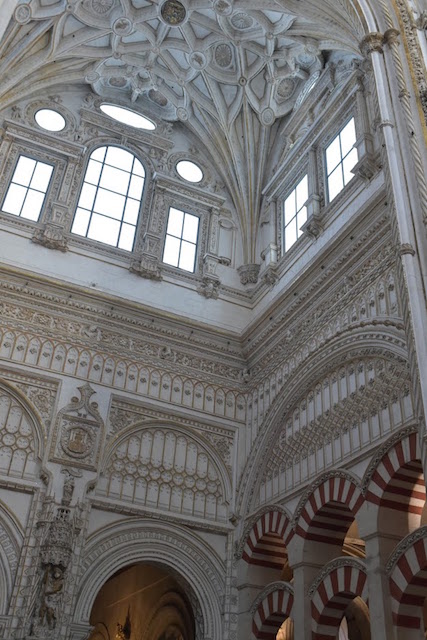
The Mezquita’s odd harmony of architectures.
Spain is a Catholic country, and its many churches have the usual votive candles. I suppose it is a kind of indulgence: you give some money, a candle lights up, and a prayer or two reaches some divine ears. Córdoba is a cheap place, and certainly you get a bigger bang for your buck here. Where one Euro in Madrid would get you one or two candles, in Córdoba you will get anywhere between four and ten candles. If I believed in such things, I would think Mama Shaw was smiling down on me. Not only was I petitioning on her behalf, but I was doing so while getting a bargain. Thriftiness: the oft-forgotten sister of cleanliness.
The votive candles go beyond the churches. They line some streets at night, and they appear in seemingly random spots along other paths. After an early visit to the Mezquita, we grabbed a quick breakfast at a place that even had one next to the toilet. In a place with such a heavy meat-laden diet, it was a nice reminder that this too shall pass.
We are now on a train heading to Barcelona. Aside from a last night in Madrid, out of which we fly, this is the last leg of this trip. Jessica is sleeping next to me. Every moment with her is one of eternal beauty. Despite your insistence, those moments together are largely due to you and Kevin. I feel grateful for that every day, and today, even more so.
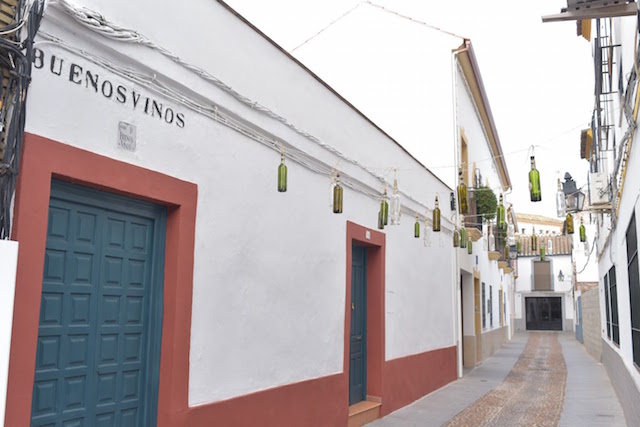
Happy Birthday, or as they might say here, Feliz Cumpleaños. Gracia for the truly wondrous gift of your presence.
Abrazo y Amor,
Pete






